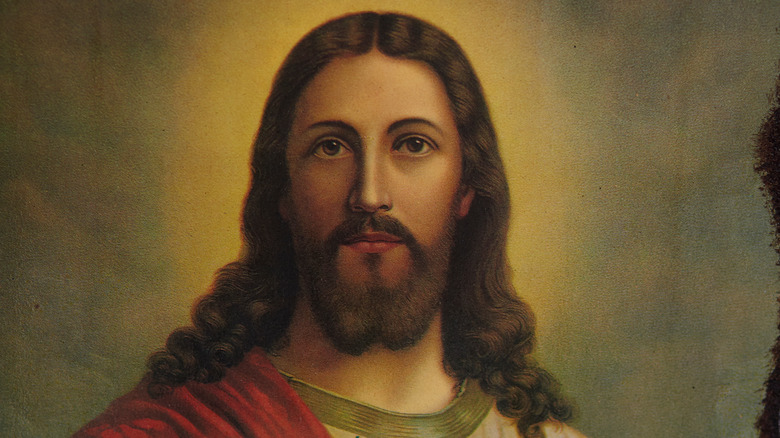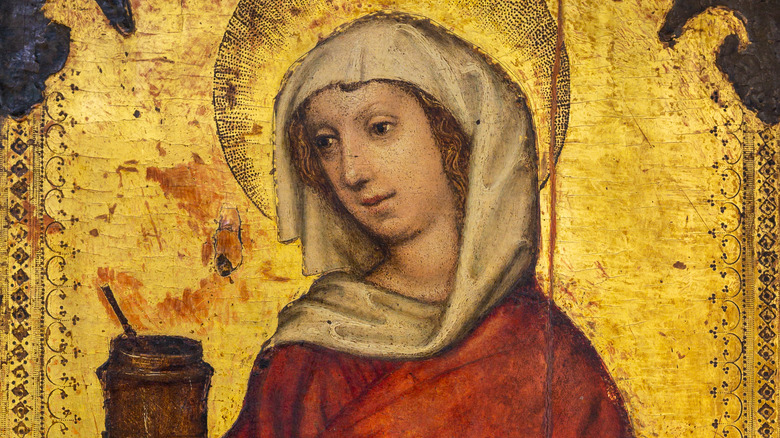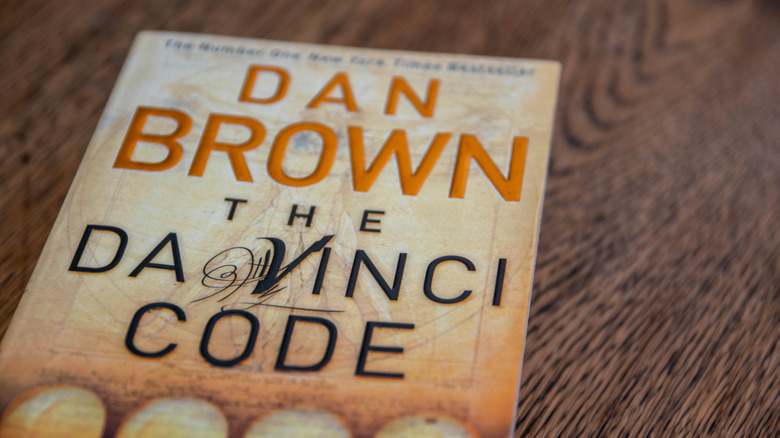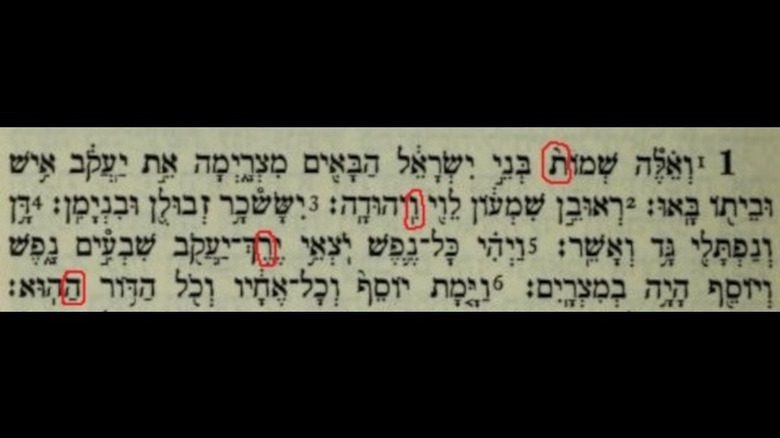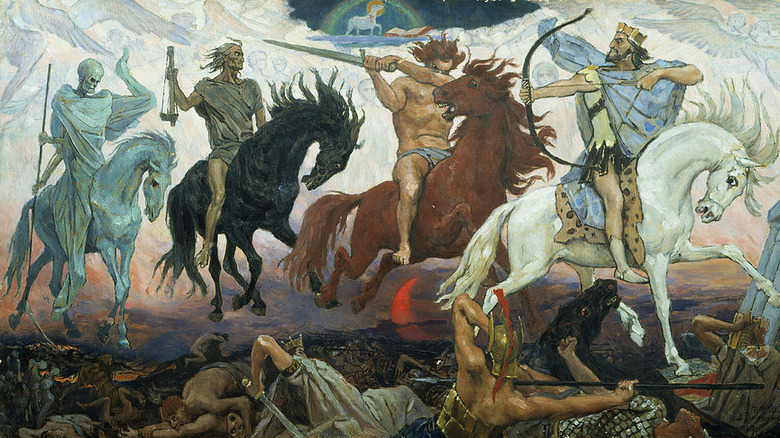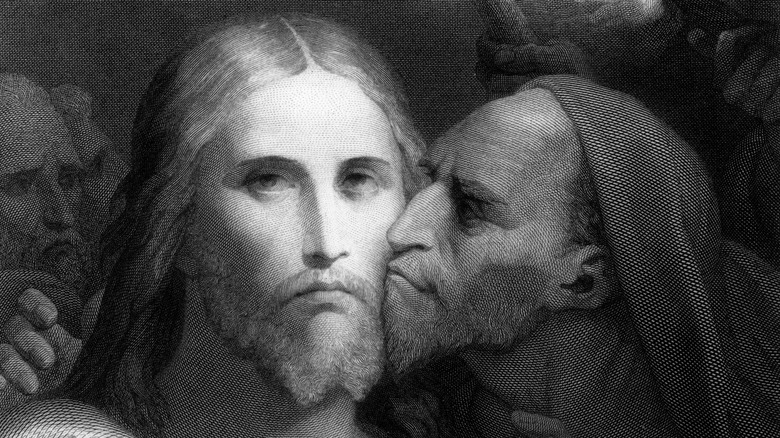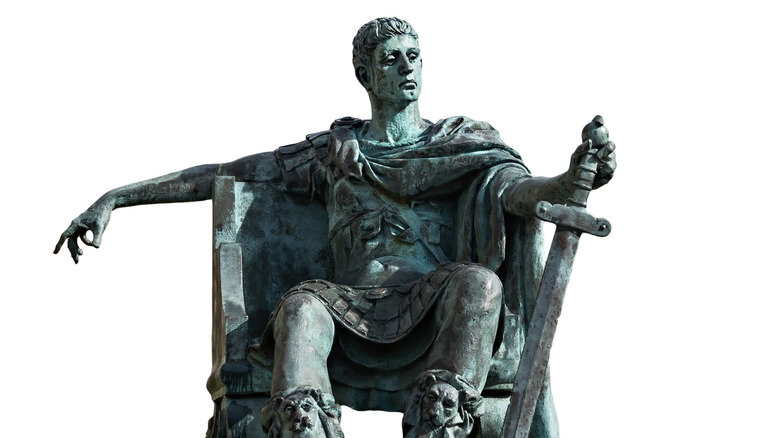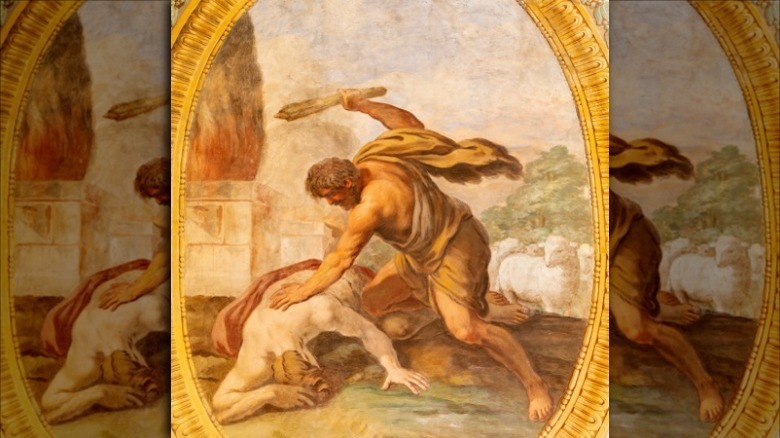Theories About The Bible That Change Everything
The Bible is sometimes referred to as the greatest story ever told. A collection of sacred texts that are believed by many to be revelations from God, its history goes back thousands of years, and it is regarded as sacred in several major religions, with billions of people using the Bible for guidance, understanding, and worship.
Of course, something that old and that steeped in religious symbolism and history isn't going to be an easy read. People have been arguing over the meaning of the writings in the Bible for almost as long as they've existed. Religions have split into new forms and wars have been fought over how to interpret the Bible, or even what's legitimately part of the Bible. So it shouldn't be surprising that in the modern age there are more than a few crazy theories about the Bible.
Some of these theories are concerned with who authored the various parts of the Bible, some with what specific words or symbols mean, and some deal with information supposedly removed from the Bible in order to suppress truth. Whatever the theory is specifically about, one thing is for sure: these theories about the Bible that change everything.
Jesus never actually existed
The Bible is split into two main sections: the Old Testament, which Britannica explains is also the Hebrew Bible, and the New Testament, which compiles the teachings of Jesus and serves as the foundation of the Christian religion. The Bible is a collection of stories, songs, poems, letters, and apparent historical accounts — it's all over the place. And while many of the people and events discussed in the Bible can be verified by examining surviving documents and monuments, some can't. Some have long been mysterious, but more recently confirmed to have existed. For example, the Independent reports that until 1961, there was no historical evidence that Pontius Pilate, the Roman governor of Judea who ordered Jesus's execution, actually existed.
Some people believe there's insufficient evidence that Jesus Christ even existed. As reported by the Guardian, the Jesus-Myth theory suggests that Christ was invented along with most of the events in the New Testament. The Washington Post explains that the earliest sources that refer to Jesus of Nazareth were written decades after the alleged events surrounding him. These writings also fail to provide any evidence or other crucial details to support their version of events. The Jesus-Myth theory argues that the Bible was written as a way to manipulate and control people, which would certainly change everything for the billions of people who have placed their faith in it.
Reincarnation was removed from the Bible
Most of us are familiar with the concept of reincarnation: The idea that when you die, you are reborn into a new life, usually without any memory of this one or any of the others you've no doubt lived. Britannica explains that many major religions including Buddhism and Hinduism hold reincarnation as one of their core tenets.
But not Christianity. In the Christian church, you are born and given one life. After that, you pass into the afterlife, where you are judged and sent either to heaven, hell, or perhaps purgatory. You're never reborn again.
But, as reported by the Inquisitr, there is a theory that the earliest teachings of the Christian church did indeed include reincarnation. According to the theory, the teachings were removed when the Church began organizing the texts that would become the official Bible. Reincarnation undermined the spirtual system of judgment that the Church taught. In "Reincarnation in Christianity," author Geddes MacGregor explains that reincarnation was systematically suppressed and references to it were removed from the Bible entirely. MacGregor points out that many early Christians openly believed in reincarnation, and that the Gnostic Christians also included a belief in reincarnation in their teachings.
Mary Magdalene was an apostle
Mary Magdalene is one of the most interesting characters in the Bible. As explained by Time, for thousands of years the popular image of Magdalene was of a former prostitute, a "fallen woman" who found salvation through faith in Jesus. But in 1969, the Catholic church admitted that this interpretation was not actually supported by the text of the Bible. In fact, as explained by Smithsonian Magazine, many believe that the Bible explicitly supports the idea that Magdalene wasn't just a female follower of Jesus, but was perhaps his most important follower — that she was, in fact, an Apostle.
This theory argues that Magdalene's status threatened the patriarchal structure of the Church. Reworking her public image into a wretched sex worker whose sole connection to Jesus lay in his mercy towards her not so subtly underscored the idea that women and the sexual temptation they represented were to be controlled and oppressed.
In fact, as noted by Time, Magdalene's stature in the Bible has often been used to justify calls for women to be admitted to the priesthood. These calls were amplified when the Church admitted Magdalene had probably not been a sex worker. If the theory that Magdalene was an Apostle gains ground, it could change everything about the Christian church.
Jesus married and had kids
If you ever read "The Da Vinci Code" by Dan Brown, you already know this one. In that story, the huge secret being covered up by the Catholic church is that Mary Magdalene wasn't simply a follower of Jesus. Rather, she was his wife, and after his death she fled to what is modern-day France and gave birth to his daughter. More importantly, the bloodline still exists today.
As it turns out, there are plenty of people who think that might not be fiction. As reported by the Independent, there is a large gap of time in Jesus's life that we know almost nothing about — from when he was about 8 days old until he was in his early 30s. There is just one mention of Jesus during this time: he traveled with his parents to Jerusalem when he would have been about 12.
But an ancient document known as the "Lost Gospel" fills in some of Jesus's story, and tells us that he married Mary Magdalene and had two children with her. It's not the only reference to Jesus being married, either — ABC News notes that an ancient Egyptian scroll called the "Gospel of Jesus's Wife" also references the possibility.
The Bible is one enormous code
Even if you believe the Bible came directly by God, there's little doubt that's a messy book. Composed over the course of thousands of years in several languages, using different styles and forms, and codified via committees with varying agendas, one thing is certain: There was no editor guiding the narrative and ensuring everyone stuck to the house style.
Unless, of course, the editor was God. The theory that everything in the Bible was specifically dictated by God using those famous "mysterious ways" is an old one. A Publishers Weekly description of "Cracking the Bible Code" explains that some scholars believe that God literally dictated the Torah to Moses letter-by-letter. That's given rise to various theories that the text of the Bible isn't just a symbolic compendium of God's laws and teachings, but also an insanely complex code.
According to scientist "Who Wrote the Bible Code?," an 18th-century rabbi named Eliyahu ben Shlomo argued that all of creation — including everyone who will ever live and the details of their lives — is encoded in the first five books of the Torah. Big Think reports that scientists have used a technique called Equidistant Letter Sequence (ELS) to spot strange language patterns in the Bible, which seem to reveal coded messages, giving rise to books like "The Bible Code" by Michael Drosnin. But as noted by Real Clear Science, the technique also yields hidden coded messages in "Moby Dick" and "War and Peace."
Revelation has already begun
The Book of Revelation is one of the strangest part of the Bible. It's written in a style completely different from the rest of the book, and is filled with horrifying imagery, and follows a dream logic. This has led to a wide variety of interpretations, with some arguing it's a coded description of events that were current at the time or events much further in the past — though the most familiar and popular interpretation is probably that's it's describing the Apocalypse, when the world ends and God calls us all to judgment. That places the events of Revelation, with its seven seals and pale horses and four horsemen, in the future, which is where most people like their end-of-the-world scenarios.
But some people believe a theory that the events described in Revelation aren't in the past or the future — they're unfolding all around us and have been for centuries. Beliefnet explains that the historicist view of Revelation states that the events described in Revelation won't happen all at once, but over the course of a very long time, and in a process that began long, long ago. Christianity Today reports that historicists see Revelation as the entire history of the Church — including its future — encoded in the Bible.
Judas is the real hero
The name Judas has evolved into a byword for traitor. Even the non-religious know that Judas sold out Jesus to the Romans in exchange for 30 pieces of silver.
But, as explained by Beliefnet, there's a theory that says Judas wasn't a traitor or a villain — he was actually a hero who sacrificed himself to ensure Jesus could return to heaven. In this reading of the story, Judas was acting under Jesus' instructions, and his soul was the one sacrificed in order to save the world.
The Globe and Mail reports that this theory is rooted in the apocryphal Gospel of Judas, an ancient text excluded from the Bible that shines a much different light on Judas's story. The nature of Judas's heroism is tied up in the complex beliefs of a Christian sect known as the Gnostics. That's also why the text was excluded, because the Gnostics were suppressed by the mainstream Church. But, as the Conversation notes, the Gospel of Judas suggests that Jesus knows of Judas' betrayal and allows it.
The Bible is actually somewhat ambiguous concerning Judas' status. Jesus speaks of him warmly even in the midst of his betrayal, and the other Apostles are not exactly heroic, abandoning Jesus at the crucial moment of his arrest.
The Council of Nicea manipulated the Bible
The Christian religion has been around for a long time — more than 2,000 years. It's easy to think that the settled, established Church and the Bible it celebrates came into the world fully formed, but that isn't the case — it took centuries for the various branches of Christianity to adopt standard sets of beliefs and formalize the language in the Bible. There's been a conspiracy theory surrounding this process for almost as long.
A explained by bethinking.org, there's a theory that the Apostle Paul changed the actual message taught by Jesus. BBC Religions explains that Paul was massively important to Christianity — he wrote nearly half the Bible, and he's generally regarded as responsible for promoting Christianity from a cult into a worldwide religion. But some wonder if Paul recorded Jesus' teachings accurately, or if he altered them to suit himself. After all, we only have Paul's word on what Jesus actually said.
The theory then moves on to the year 325. According to HowStuffWorks, that's when the emperor Constantine the Great convened the Council of Nicea to clean up the mess of scripture and doctrine that had accumulated. According to the theory, this is where the books for the Bible were chosen (and others excluded and suppressed) and the process of changing the teachings of Jesus begun by Paul was completed by Constantine, who used this popular new religion to control his subjects.
It's all actually about aliens
There's an unofficial rule about any historical mystery: eventually someone will speculate that it's actually about aliens. From the pyramids to the myth of Atlantis, someone has written a lengthy article somewhere about how it's all about aliens.
The Bible is no exception. According to Beliefnet, the theory goes that the Bible is actually about a race of super-advanced aliens and Jesus was actually an alien-human hybrid. UFO Digest notes that plenty of biblical details lend themselves to this theory. The Star of Bethlehem can be seen as the arrival of a spaceship, the missing decades of Jesus' life were a period in which the aliens taught Christ what he needed to know to control humanity, and his resurrection and rise into heaven was him being beamed back to the mothership.
Tabletalk Magazine observes that it's easy to read the Prophet Ezekiel's description of angels flying in a craft described as "wheels within wheels" as clear evidence of something being piloted by aliens, and some regard it as the earliest recorded UFO sighting.
This isn't some old, musty theory, either. As SPIN explains, musician Tom DeLonge of Blink-182 fame has explored the possibility that aliens explain many of the strange and supposedly holy happenings in the Bible.
The Bible describes time travel
Some pretty incredible stuff happens in the Bible. You've got angels, resurrections, and burning bushes that speak. So it's probably not too surprising that there's a theory that the Bible pretty blatantly describes time travel, and that it even holds the secrets the secrets of the technology.
Jason Colavito explains that the theory pivots off of a story involving the prophet Jeremiah. One day, Jeremiah is sitting with some friends and tells a young boy named Abimelech to go get some figs. The kid goes to a nearby hill, blacks out, and when he wakes up he's still a kid but 62 years have passed.
Colavito goes on to note that this story of Jeremiah is apocryphal — that is, deprecated and excluded from the Bible, and that it seems to be clearly mythological. Compelling Truth notes that a complicating factor is this theory is the fact that God exists outside of time, and of course, as God can do anything he likes, including manipulate time when it suits him. Some of the evidence of time travel in the Bible comes from visions of the future God brings to people like John, the author of the Book of Revelation.
God didn't take a rib from Adam to make Eve
https://www.discovermagazine.c...According to Scientific American, it is an oddity of evolution that humans are among the only primates to lack a penis bone, otherwise known as the baculum. Some folks reject the idea that there are evolutionary explanations for this, preferring instead a theory that the reason we lack baculums is because God took them away from men. Specifically, God took Adam's baculum — and not his rib — to make Eve.
As explained by UCL Researchers in Museums, this theory actually has some mainstream acceptance. Some support for the theory comes in the possibility that the word used in the original Hebrew, "tzela," can be translated as a more general term for a supporting structure of bone — meaning that taking it to mean rib is more of a choice than a hard-coded definition. Even more interesting, Discover Magazine notes that ancient Hebrew actually had no specific word for penis and relied on several different euphemisms. One such euphemism was the word "pleura," which translates to "side," which in turn might have been confused with the side of your torso, i.e. your ribs.
The final piece of evidence for this theory is the fact that taking a bone from the penis would be somewhat in line with generating new life, whereas a rib is just a rib.
The Mark of Cain justifies racism
The story of Cain and Abel is one of the best-known in the Bible. The sons of Adam and Eve, Cain became jealous of Abel when God took Abel's sacrifice in preference to Cain's. Enraged, Cain murdered his brother, so God marks him and exiles him. The "Mark of Cain" comes from this story, generally used to convey shame and guilt.
The theory that has grown up around this mark stems from the fact that nowhere in the Bible is the mark identified or explained. That's led some people to imagine some pretty racist stuff. The Salt Lake Tribune explains that the Mormon Church at one point believed that the mark was dark skin, which provided an argument for not allowing non-white people into the priesthood while also conveniently excusing racist attitudes. The Church of Latter-Day Saints admits that this was once the case, explaining that the church's founder, Brigham Young, put the restriction in place in 1852, and citing the Mark of Cain as one reason. But Young also believed the curse would someday be lifted and Black people could eventually be afforded full privileges in the Church, which American heritage notes officially occurred in 1978.

